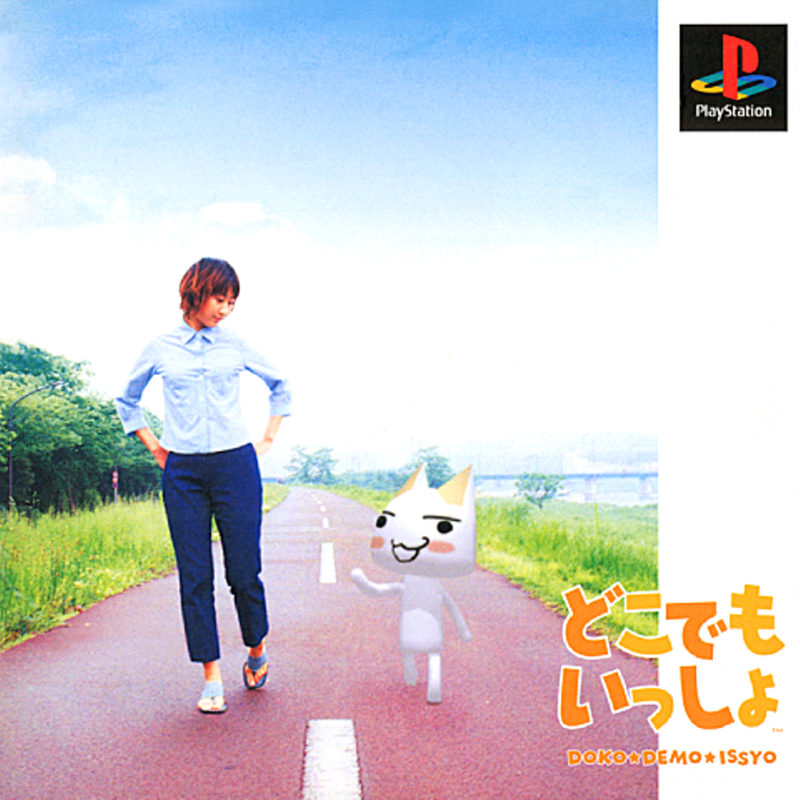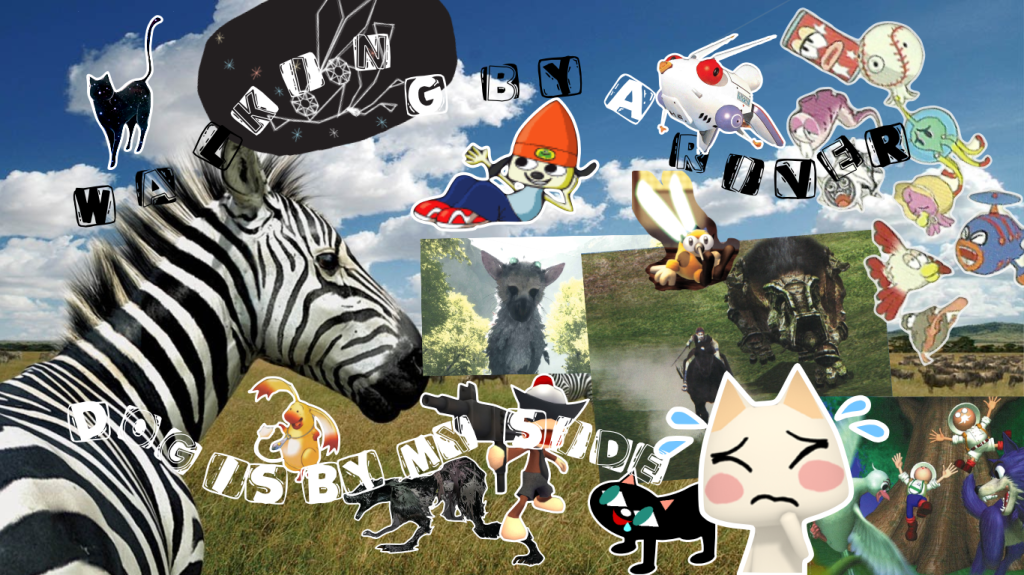In Tokyo Jungle, you play as one of many animals–though you start out as a cute little abandoned Pomeranian dog–trying to survive in a Tokyo where humans have mysteriously disappeared. The game is an action sort of thing where you move your animal around the city streets and stalk prey (or delicious greens if you play an herbivore) to keep yourself fed while working to impress female animals and reproducing before you drop dead of old age. You carry on as successive generations of animals, trying to get stronger and, secondarily, unravel some of the mysteries surrounding the disappearance of human beings from the city. It’s generally a little ugly but very fun to play and, importantly, very funny as well. I defy anyone not to laugh the first time you make a house cat jump out of the tall grass to try to murder a hippopotamus. While you’re all recovering from your laughing fits, though, there is a little bit of preamble to get out of the way. Unfortunately, little of it is pleasant.
In 2020, Sony declined to renew most of the contracts for staff at Japan Studio. News trickled out and eventually we all learned that Sony had finally dissolved Japan Studio while maintaining a rump remnant. A small group of enthusiasts bemoaned this decision, but there was nothing you could do. Sony had just shut down its oldest game development arm, the office that had anchored its console business from the earliest days and defined its creative contribution to the medium of video games. It was also the last gasp for Sony’s own attempts to grow its customer base in its notional homeland of Japan. With PlayStation’s Japanese audience waning ever since 2004 or so and the relocation of Sony’s console gaming division to California in the mid-2010s, Sony already signalled Japan Studio’s corporate, economic irrelevance. And, though it put its name on a handful of great games in its grinding final days–Gravity Rush 2, Bloodborne, the sequel to Oreshika, and the incredible Everybody’s Golf for PlayStation 4–the fire had gone out long before that.
The reality was that Japan Studio as it originally existed had been dead and gone for almost eight years at that point. In order to discipline the studio and make it more useful to Sony’s global software ambitions, PlayStation put an American crony by the name of Allan Becker in charge of the studio sometime around 2011 or 2012. Ruthlessly culling smaller projects, he ended Japan Studio as it was. While the attempt to remake Japan Studio into a hitmaking machine did not quite work, Becker’s corporate-approved, American style approach to management led to the studio producing far fewer and far less interesting games.
Tellingly, two of the bigger games that the studio did end up making in the 2010s were vanity projects dreamt up by engineering genius and (judging from his creative output) boring dullard Mark Cerny. Another, the fantastic but–in terms of gameplay design–safe and trend-following Puppeteer was the brainchild of a British producer named Gavin Moore, another sign that Sony trusted its European and American staff to produce hits while their Japanese studios played second or third string. Those games didn’t even sell that well in the end, which might have been just as well. As PlayStation’s studios in Amsterdam and California put out hits built around sturdy, extremely rote ideas and truckloads of staff and money, there was no more room in Sony for Japan-only games or games that tried to defy industry common sense. Sony, in opposition to Microsoft and Nintendo’s attempt to reach non-hobbyist audiences, threw in its lot with the stock gaming enthusiast. Though capable of being very intelligent, these fans who, like their aging comic book store counterparts, have a deathly fear of getting ripped off, fetishize a sterile and packaged “coolness,” and throw a fit if anything about a product seems too weird or unexpected.
My somewhat harsh caricature aside, I see a few core reasons why Japan Studio eventually got reorganized out of recognition before being dissolved in 2020. These are, in no particular order:
- The decline of the Japanese TV console gaming market in favour of mobile phone games, PC games, and portable systems. Sony took this decline especially hard, slipping from dominating its home country from 1995-2005 or so to fading into near-irrelevance in the face of Nintendo’s renewed power.
- The way the PlayStation 3 struggled for Sony initially and, most importantly, the way that it seemed to recover because of huge, conservative action games like Uncharted. This underscored the importance of high-budget, story-driven, cinematic game projects that could capture players with spectacle. These kinds of projects have only become more dominant and more expensive within Sony ever since.
- The period from 2006-2014, a really depressing low point in the history of video game development creativity that also set the stage for out-of-control budget increases, increasing team sizes, and massive technological demands that drove the homogenization of large-scale game development. Most odiously, this era also became defined by a sickening anti-Japanese strain of talk in gaming circles, stinking with American cultural arrogance and generally ruining so, so many conversations about video games for about a decade.
- Sony’s core electronic business has also been in stasis or decline for decades now, making the PlayStation platform increasingly important to the company and, therefore, not afforded the creative and business liberties it once held.
One reason that does not convince me as much is the argument that Japan Studio had gone into a severe creative decline after the release of the PS3. Yes, there was never a big Ape Escape game for PS3 and Sony declined to revive bigger hits like Parappa on the third PlayStation, Japan Studio released a lot of games for the system that closed-minded and ignorant critics and gamers either ignored or dismissed. While most of its higher-profile projects ended up on the PlayStation Portable because of its greater success in Japan, the studio still released Afrika, Aquanauts Holiday: Hidden Memories, Boku no Natsuyasumi 3, Folklore, and Demon’s Souls to retail along with a raft of wonderful smaller games like Trash Panic, Echochrome, The Last Guy, and latecomer Rain. It’s a huge variety of excellent work, and puts the lie to the idea that Japan Studio struggled to release worthwhile games during this time. What it could not do, seemingly, was make anyone outside of Japan take notice.
Tokyo Jungle arrived from the mind of one Yohei Kataoka, who had little experience making games before this one. As explained in this article, Kataoka’s developer Crispy’s went through numerous prototypes before nailing a fun concept. Their approach, which built up from the idea of mashing up appealing animal characters and a ghost town setting, grew organically into what became Tokyo Jungle. The core appeal of the game is that its action is punchy and immediate, the violence abrupt, hilarious, and tied into real animal life cycles just enough to mesh well with the game’s area control system. In order to breed, the player has to seize control of waypoints by marking them as their territory. Only then will the game allow the player to choose a female animal in the area with whom to parent a new generation of creatures. Though the player starts as a Pomeranian, you can unlock a huge number of other animals to play with, including kangaroos, dinosaurs, and a robotic dog that seems like a winking reference to Sony’s AIBO.
In some ways Tokyo Jungle feels like an unintentional inversion of Afrika. Where that game’s appeal rests on whisking the player through an informative adventure through a simulated African photo safari, Jungle turns the city over to the animals. Bristling with dangers, the streets of the Tokyo jungle play as a kind of satire of the peaceful savanna and wetland landscapes of Afrika. In the latter game, you outfitted your journalist protagonist in premium photography gear and in Tokyo Jungle you can decorate your animal avatar in kitschy junk you find on the streets–remnants of happier times. For humans at least.
Ever since starting this series with the conservation adventure Wonder Trek, I’ve developed a keener appreciation for how many games Japan Studio made that spotlighted animals in unique ways. Whether that meant emphasizing comedy like in Mister Mosquito or Tokyo Jungle or aiming at a sublime reverence as in Aquanauts and Afrika, to me these works stand as the medium’s most insightful body of animal-centred games. We’ve seen animals as companions in this series, we’ve seen them as goals to find, as objects of curiosity, as funny, as intriguing, as violent, as vital, as unique beings.
More generally, I am unsure if any studio has ever contributed as much to the art of games as Sony’s Japan Studio. From 1995 to around 2012 they consistently ignored trends, released daring work, and more than anyone else brought some real dignity to the idea that games are a medium of creative expression. While gaming technology can claim a number of well-known heroes from John Carmack to Yu Suzuki and on and on, very few large institutional forces in video games have put out half as much great creative work as Japan Studio in their entire histories. Sony itself is a desert at this point, Microsoft is going on its own scorched earth rampage shutting down anyone doing interesting things on their dime, and while Nintendo has always embodied a unique sense of fun and tactile pleasure, they are also very conservative–more idiosyncratic than artful, to make a fine distinction. Even independent developers today are often consumed with reproducing nostalgic tingles than pushing for personal expression and serious use of the medium. This is why I miss Japan Studio.
As you learn very quickly in Tokyo Jungle, even a very successful dynastic family of Pomeranians can quickly perish in the jaws of a panther. We’ve lost Japan Studio and, even worse, much of its legacy of great games remains completely unknown to people who only read and speak English. Sony, to be blunt, does not care about its history. So it falls to enthusiasts, journalists, fans, and academics like me to try to put our fingers on the scale. To me, a world where more people have played more of Japan Studio’s games is at least a marginally better one. They also embody the best aspects of cross-cultural communication. As Tokyo Jungle’s creator Kataoka said during a conference talk:
“I personally feel it’s not necessary for Japanese companies to think about marketing to the West when making games. Creating what you want will eventually introduce new ideas and values to the west.”
And in an age where Japanese media has a more prominent place in the Anglosphere than ever, I think this thought really summarizes the tragedy of Japan Studio’s shortsighted closure.
Best of luck to all of you.

















